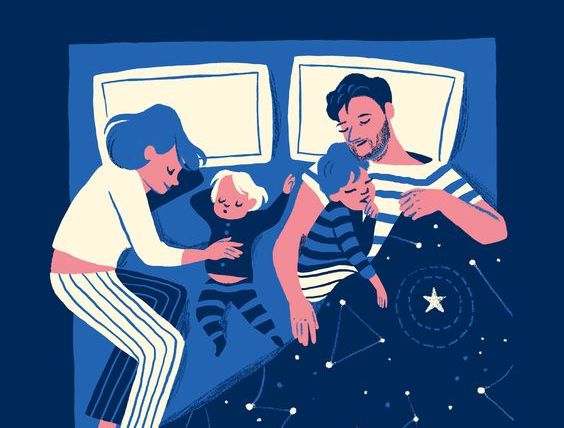Waking Up With Dad and Baby, That's Happiness

Waking up together, opening your eyes to the new day, feeling the baby’s breath and the closeness between Dad and Mom is the essence of a word that should always be conjugated in the present tense: happiness.
Few scenes will remain in the memory of these parents than those moments of intimacy in the mornings; those moments shared with a new life, that are inscribed in our brains with the threads of love, with the glue of partnership and through the keyhole of well-being where we will look in the future, remembering such magical moments.
To wake up together is, after all, the essence of co-sleeping, a personal practice that only parents can choose to do together. It is clear that not everyone agrees; we know there are often those who go to the pediatrician and keep it a secret that they sleep with their baby, because somehow we fear the reaction of the professionals, who warn us of the risks in case we do not do it well.
However, instinct is wise, and dads know how to prepare the bed, how to place the baby and what to do at all times so that rest is never at odds with safety. There will be time for our little one to sleep in his own room, which is something that will come little by little and that he himself will ask us for when we least expect it.
Until then, Mom and Dad are still nesting, enjoying those magical awakenings with their baby very close to the both of them…
Waking Up at Your Side, That’s Balance, That’s Peace
The baby who wakes up countless times throughout the night has no problem whatsoever. Nothing is wrong with him. He is not always sick. He is not a difficult child. He is a normal baby who only craves one thing: his mother’s closeness.
We must remember that when a baby is born, his brain is still very immature. It needs three things: food, safety and routine. The latter is what will help you to regulate his circadian rhythms a bit, to differentiate day and night, to understand that after a bath comes rest, and that mom will always be there when needed, that he should not be afraid because he will always be cared for and fed.
This biological and emotional stability will come with time. It is around age 3 when the child has more mature brain structures that allow a continuous rest throughout the night without awaking, or without that instinctual “fear” that makes them need their parents constantly. Until then, and if parents want it, co-sleeping can be very beneficial.

Thermal Synchrony Between Mother and Child
Sleeping together not only allows the baby to feel more relaxed, safe and protected, but also allows him to better regulate his body temperature.
- It is known that when the baby has skin-to-skin contact with the mother, the temperature of the breast changes according to the child’s needs. If the child is cold, the temperature of the breast will rise two degrees to warm it, and if the baby is already warm, the temperature of the breast is reduced.
- This phenomenon is called thermal synchrony and has a magical and exclusive purpose: to promote the essential care of the baby during the first years, because it is that place, the breast of the mother, that is a crucial space in the child’s life.
We Are Humans and We Like to Have Our Caretakers Close
The only rock I know that stays steady, the only institution I know that works is the family. – Lee Iacocca
Waking up in the morning together, receiving the new day in the tranquility of our bed and feeling close together confers a great benefit to our emotional world, our brain. This is for a very simple reason: we are human, we are social beings and we need to have our caregivers very close.
- This is not just for the baby. We know that in the first years of life, the closeness of mothers and fathers is key to the baby’s livelihood.
- But it’s also important to remember that Mom is the caretaker of Dad and Dad is the caretaker of Mom. The couple feels secure to be close, to feel each other, to open their eyes in the middle of the night and sense that we are accompanied by the most important person, the one to whom we have offered our heart.

Therefore, sleeping together and nesting together with the baby will unite our bonds much more. We are mutual caregivers; we need it. That is why sharing a small space at night while sleeping is incredibly beneficial to all.
All cited sources were thoroughly reviewed by our team to ensure their quality, reliability, currency, and validity. The bibliography of this article was considered reliable and of academic or scientific accuracy.
- Landa Rivera, L., Díaz-Gómez, M., Gómez Papi, A., Paricio Talayero, J. M., Pallás Alonso, C., Hernández Aguilar, M. T., … & Lasarte Velillas, J. J. (2012). El colecho favorece la práctica de la lactancia materna y no aumenta el riesgo de muerte súbita del lactante: Dormir con los padres. Pediatría Atención Primaria, 14(53), 53-60. http://scielo.isciii.es/pdf/pap/v14n53/revision1.pdf
- Horsley T, Clifford T, Barrowman N, Bennett S, Yasdi F, Sampson M, et al. (2007). Benefits and harms associated with the practice of bed sharing. Arch Pediatr Ado- lesc Med. 2007;161:237-45.
- Martin Martin, R., Sanchez Bayle, M., & Teruel de Francisco, M. C. (2017). El colecho en nuestro medio: estudio de casos y controles en las consultas pediátricas de Atención Primaria. Pediatría Atención Primaria, 19(73), 15-21. http://scielo.isciii.es/scielo.php?script=sci_arttext&pid=S1139-76322017000100003
- Rodríguez Villar, V., Moreno, M., & Navío, C. PRACTICANDO EL COLECHO. ASESORAMIENTO DE LA MATRONA. http://www.trances.es/papers/TCS%2005_3_6.pdf
- Ball, H. L., Hooker, E., & Kelly, P. J. (2000). Parent–infant co‐sleeping: fathers’ roles and perspectives. Infant and Child Development: An International Journal of Research and Practice, 9(2), 67-74. https://onlinelibrary.wiley.com/doi/abs/10.1002/1522-7219(200006)9:2%3C67::AID-ICD209%3E3.0.CO;2-7
